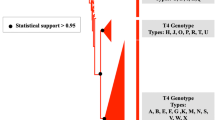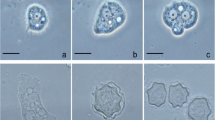Abstract
Acanthamoeba is a widespread free-living amoeba capable of causing serious infections in humans and other animals, such as amoebic keratitis, disseminated infections, and fatal encephalitis. Strain identification is usually based on 18S rDNA sequencing, which allows the distinction of over twenty genotypes. Most sequences from environmental and clinical samples belong to the T4 genotype, which can be divided into seven subtypes, T4A to T4G, and by a nearly similar grou** of mitochondrial sequences into T4a to T4j subtypes. The co-clustering of nuclear and mitochondrial groups can be very useful for a better identification of lineages within the very rich T4 genotype. In this study, we provided molecular phylogenetic evidence for the delineation of a new nuclear subtype, hereafter labelled T4H, and its co-clustering with the mitochondrial T4j subtype. At least three cases of amoebic keratitis are due to strains belonging to this new group, present mainly in fresh water and detected in various countries (France, Iran, India and China).



Similar content being viewed by others
Data availability
The data discussed is provided in the text and in supplementary material. Additional information may be provided by the corresponding author upon reasonable request.
References
Behera HS, Panda A, Satpathy G, Bandivadekar P, Vanathi M, Agarwal T, Nayak N, Tandon R (2016) Genoty** of Acanthamoeba spp. and characterization of the prevalent T4 type along with T10 and unassigned genotypes from amoebic keratitis patients in India. J Med Microbiol 5:370–376. https://doi.org/10.1099/jmm.0.000234
Behniafar H, Niyyati M, Lasjerdi Z (2015) Molecular characterization of pathogenic Acanthamoeba isolated from drinking and recreational water in East Azerbaijan, Northwest Iran. Environ Health Insights 9:7–12. https://doi.org/10.4137/ehi.s27811
Booton GC, Kelly DJ, Chu YW, Seal DV, Houang E, Lam DS, Byers TJ, Fuerst PA (2002) 18S ribosomal DNA ty** and tracking of Acanthamoeba species isolates from corneal scrape specimens, contact lenses, lens cases, and home water supplies of Acanthamoeba keratitis patients in Hong Kong. J Clin Microbiol 40:1621–1625. https://doi.org/10.1128/jcm.40.5.1621-1625.2002
Corsaro D (2020) Update on Acanthamoeba phylogeny. Parasitol Res 119:3327–3338. https://doi.org/10.1007/s00436-020-06843-9
Corsaro D (2022) Acanthamoeba mannose and laminin binding proteins variation across species and genotypes. Microorganisms 10:2162. https://doi.org/10.3390/microorganisms10112162
Corsaro D, Venditti D (2010) Phylogenetic evidence for a new genotype of Acanthamoeba (Amoebozoa, Acanthamoebida). Parasitol Res 107:233–238. https://doi.org/10.1007/s00436-010-1870-6
Corsaro D, Walochnik J, Köhsler M, Rott MB (2015) Acanthamoeba misidentification and multiple labels: redefining genotypes T16, T19 and T20, and proposal for Acanthamoeba micheli sp. nov. (genotype T19). Parasitol Res 114:2481–2490. https://doi.org/10.1007/s00436-015-4445-8
Dodangeh S, Kialashaki E, Daryani A, Sharif M, Sarvi S, Moghaddam YD, Hosseini SA (2018) Isolation and molecular identification of Acanthamoeba spp. from hot springs in Mazandaran province, northern Iran. J Water Health 16:807–813. https://doi.org/10.2166/wh.2018.098
Geisen S, Fiore-Donno AM, Walochnik J, Bonkowski M (2014) Acanthamoeba everywhere: high diversity of Acanthamoeba in soils. Parasitol Res 113:3151–3158. https://doi.org/10.1007/s00436-014-3976-8
Gu X, Lu X, Lin S, Shi X, Shen Y, Lu Q, Yang Y, Yang J, Cai J, Fu C, Lou Y, Zheng M (2022) A comparative genomic approach to determine the virulence factors and horizontal gene transfer events of clinical Acanthamoeba isolates. Microbiol Spectr 10:e0002522. https://doi.org/10.1128/spectrum.00025-22
Maciver SK, Asif M, Simmen MW, Lorenzo-Morales J (2013) A systematic analysis of Acanthamoeba genotype frequency correlated with source and pathogenicity: T4 is confirmed as a pathogen-rich genotype. Eur J Protistol 49:217–221. https://doi.org/10.1016/j.ejop.2012.11.004
Mahmoudi MR, Maleki M, Zebardast N, Rahmati B, Ashrafi K, Sharifdini M, Karanis P (2022) Identification of Acanthamoeba spp. from water and soil of public parks in the north of Iran. J Water Health 20:1604–1610. https://doi.org/10.2166/wh.2022.193
Malavin S, Shmakova L (2020) Isolates from ancient permafrost help to elucidate species boundaries in Acanthamoeba castellanii complex (Amoebozoa: Discosea). Eur J Protistol 73:125671. https://doi.org/10.1016/j.ejop.2020.125671
Marciano-Cabral F, Cabral G (2003) Acanthamoeba spp. as agents of disease in humans. Clin Microbiol Rev 16:273–307. https://doi.org/10.1128/CMR.16.2.273-307.2003
Megha K, Sharma M, Gupta A, Sehgal R, Khurana S (2021) Microbiological diagnosis of acanthamoebic keratitis: experience from tertiary care center of North India. Diagn Microbiol Infect Dis 100:115339. https://doi.org/10.1016/j.diagmicrobio.2021.115339
Niyyati M, Lorenzo-Morales J, Rahimi F, Motevalli-Haghi A, Martín-Navarro CM, Farnia S, Valladares B, Rezaeian M (2009) Isolation and genoty** of potentially pathogenic Acanthamoeba strains from dust sources in Iran. Trans R Soc Trop Med Hyg 103:425–427. https://doi.org/10.1016/j.trstmh.2008.12.007
Rahman MM, Yagita K, Kobayashi A, Oikawa Y, Hussein AIA, Matsumura T, Tokoro M (2013) Genetic characterization of clinical Acanthamoeba isolates from Japan using nuclear and mitochondrial small subunit ribosomal RNA. Korean J Parasitol 51:401–411. https://doi.org/10.3347/kjp.2013.51.4.401
Saberi R, Najafi A, Naserifar R (2019) Detection of Acanthamoeba spp. from dust phenomenon in Ilam Province, West Iran. Acta Microbiol Immunol Hung 66:459–468. https://doi.org/10.1556/030.66.2019.011
Shokri A, Sarvi S, Daryani A, Sharif M (2016) isolation and genoty** of Acanthamoeba spp. as neglected parasites in North of Iran. Korean J Parasitol 54:447–453. https://doi.org/10.3347/kjp.2016.54.4.447
Stothard DR, Schroeder-Diedrich JM, Awwad MH, Gast RJ, Ledee DR, Rodriguez-Zaragoza S, Dean CL, Fuerst PA, Byers TJ (1998) The evolutionary history of the genus Acanthamoeba and the identification of eight new 18S rRNA gene sequence types. J Eukaryot Microbiol 45:45–54. https://doi.org/10.1111/j.1550-7408.1998.tb05068.x
Thomas V, Loret JF, Jousset M, Greub G (2008) Biodiversity of amoebae and amoebae-resisting bacteria in a drinking water treatment plant. Environ Microbiol 10:2728–2745. https://doi.org/10.1111/j.1462-2920.2008.01693.x
Funding
No funding was received for this study.
Author information
Authors and Affiliations
Contributions
Daniele Corsaro, study design, phylogenetic analysis, molecular analysis, structure modelling, GenBank processing and manuscript writing. Danielle Venditti, phylogenetic analysis, molecular analysis, structure modelling and manuscript writing. All authors read and approved the final manuscript.
All authors contributed to the study conception and design.
Corresponding author
Ethics declarations
Ethics approval
Not applicable.
Consent to participate
Not applicable.
Consent for publication
Not applicable.
Competing interests
The authors declare no conflict/competing interests.
Additional information
Section Editor: Sutherland Maciver
Publisher's note
Springer Nature remains neutral with regard to jurisdictional claims in published maps and institutional affiliations.
Supplementary information
Below is the link to the electronic supplementary material.
Rights and permissions
Springer Nature or its licensor (e.g. a society or other partner) holds exclusive rights to this article under a publishing agreement with the author(s) or other rightsholder(s); author self-archiving of the accepted manuscript version of this article is solely governed by the terms of such publishing agreement and applicable law.
About this article
Cite this article
Corsaro, D., Venditti, D. Molecular evidence for a new lineage within the Acanthamoeba T4 genotype. Parasitol Res 122, 1445–1450 (2023). https://doi.org/10.1007/s00436-023-07844-0
Received:
Accepted:
Published:
Issue Date:
DOI: https://doi.org/10.1007/s00436-023-07844-0




